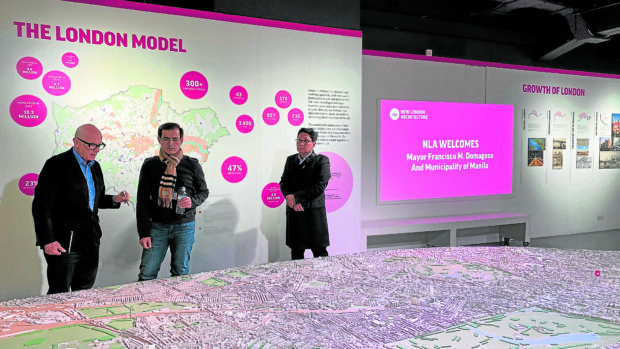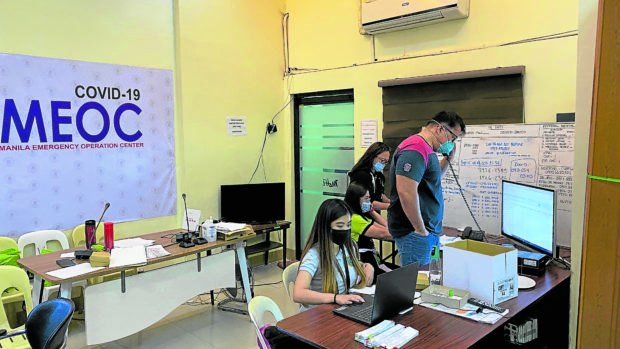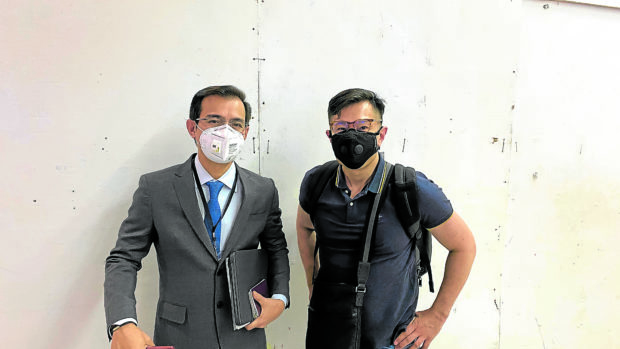
Manila Mayor Francisco “Isko Moreno” Domagoso maintains a private office adjacent to his formal one, in a corner on the second floor of Manila’s City Hall. Half of the room is dominated by a work table seating six and shares space with a large screen iMac, piles of official documents and briefing materials. On the other side are two modest faux-leather sofas facing a large screen television.
The mayor has been sleeping on one of the sofas the entire time Manila—and Metro Manila and the rest of Luzon—had been under one of the world’s longest and most severe lockdowns.
“You know what, I even fell off it the other night,” he says late one evening, in between briefings. I ask one night, Mayor, why are you sleeping in the office?
“Well, I want to act on everything, as soon as possible,” he said. “This crisis isn’t an eight-hour job; this is a 24/7 crisis, a crisis like this has not happened in maybe 100 years. We have no playbook, no guidebook; we have to address each problem after the other and frequently, multiple problems at once.” He pauses. “Where else would I be?”
Being around 24/7 gives Domagoso instant access to the data that has been critical to his management of the pandemic.
On the first floor of the same prewar building is a windowless room where the Manila COVID-19 (new coronavirus disease) Emergency Operations Center (MEOC) was established days after Domagoso arrived from London (he went from the airport to City Hall and didn’t leave for eight weeks). Usually, there are around six to 10 doctors and nurses from the Manila Health Department. They work in shifts, 24 hours a day, seven days a week, answering phones and studying data.

Much of the data comes from a bespoke back-end database built for the city, the Manila COVID-19 Digital Health Survey (DHS). Through a chatbot embedded in the mayor’s official Facebook Page—accessed by pressing the “Send Message” button, opting in and choosing language (Tagalog or English)—participants are brought through a number of questions about their health.
Just short of a self-assessment, the survey concludes by giving respondents numbers for the MEOC and the Department of Health hotline—to date, still the only dedicated 24-hour COVID-19 hotlines in the Philippines. So far, almost 200,000 Filipinos have participated in the DHS, representing the largest COVID-19 ID system of any city in the Philippines.
Shocked
“On the back end, if anyone replies he or she believe they may be suffering from difficulty breathing, or enduring a fever or suspect they may have been exposed to COVID-19 in some way, we capture that real time and within a few hours, we call them,” says acting city health officer Arnold M. Pangan, MD, RSW. “They are always shocked that we call them—as if they didn’t expect to hear from their city. But we call and we investigate, and sometimes we act. The earlier we can get to people before they get sick, the less stress we will place on the city’s health system.”
The mayor’s reliance on data and technology extends beyond the digital health survey. During the lockdown, Domagoso launched two new websites. One (www.cityofmanila.ph) is an online portal for a variety of city services. The second (www.mayorofmanila.ph) is a COVID-19 resource center, encompassing all executive orders, city resolutions and ordinances related to the pandemic.
“Just before the crisis hit, we were beginning to launch a city-wide RFID (radio-frequency identification) ID system for all Manileños,” Domagoso adds. “Manila needs data! When I took office last year, there was nothing. We inherited no systems; so many processes are still manual. We will get through this crisis if we source and access the right data. In fact, data is what we will use to rebuild the city after this crisis, whenever it is finally over.”

During the most critical weeks of the enhanced community quarantine, I was privileged to witness how Domagoso and his team confronted the coronavirus. In January, my consultancy had begun a program of work for Manila that sought to develop a new global brand for the city and build a communications infrastructure to support the mayor’s revitalization program for the city.
In early March of this year, I was asked to join Domagoso and his small delegation on a whirlwind trip to London to meet urban planners and tour key transformation areas such as Stratford City, home to Queen Elizabeth Park, the formerly contaminated brownfield site that had been successfully cleaned up for London’s 2012 Olympic games.
Less than 24 hours after our touch down in London, the Philippines reported its first locally transmitted case of COVID-19. Two hours after hearing the news, in the lobby of a businessman’s hotel on the Thames’ South Bank, Cesar Chavez, Domagoso’s chief of staff, and Jules Leonen, head of the Manila Public Information Office, facilitated a Facebook Live broadcast for the mayor.
The trip pivoted immediately from a focus on urban regeneration to public health crisis management. In a scheduled meeting with Member of Parliament Robert Graham, a meeting was proposed with the United Kingdom’s Foreign and Commonwealth Office (FCO)’s Coronavirus Task Force. Everyone in the City of Manila delegation pressed for the opportunity: Here was a chance to obtain best-practice perspective.
A couple of hours later we crowded into a small conference room on the fourth floor of the FCO office complex where Domagoso and Robert Deane, head of the task force, spoke some hard truths about the road ahead. “We have a potentially very difficult situation to confront back home,” Domagoso admitted. Deane shared a hard copy of the UK’s coronavirus plan, and armed with it, we made a sprint toward Heathrow. We had been on the ground in London barely 48 hours.
Old-style
“I think he was made for this moment, as strange as that may sound,” says longtime Manila City Councilor and acting secretary to the mayor Letlet Zarcal one evening while Domagoso is delivering his nightly Facebook Live COVID-19 update in his formal office. We are at the work table, and it is about a month into the crisis.
“His campaign was very much an old-style, retail political campaign. He did town halls, twice a day, sometimes three times a day, in almost every barangay. We made sure that it was heads of families who attended the town halls. I think we reached 60,000 heads of families.”
Though not the largest city by area or population, the City of Manila is the oldest and consequently most diverse urbanization: 897 barangays grouped into 100 zones and 16 administrative districts.

“Imagine, some barangays in Manila are just a couple of blocks,” explained architect Danny Lacuna, chief planner for the City of Manila. “But it does give us a body of local government officials that no other city has, and we are able to activate the food and cash distribution program.”
A few nights later I join the mayor and vice mayor Honey Lacuna in a two-hectare warehouse where sacks of rice are being stockpiled. “We are going to prepare to live with this crisis for some time. We don’t know how long this will last or how many lockdowns we will have to endure until a vaccine becomes available. But Manila will be prepared, and we won’t stop at this,” Domagoso declares.
Since his landslide election in May 2019, he has applied a take-charge approach to tackling the problems of the 449-year old Philippine capital city.
“Manila’s woes are well known,” says architect Joy Dawis-Asuncion, head of the mayor’s Special Project Team. “Approximately 60 percent of the estimated 1.9-2 million population live under the poverty level, the highest ratio in Metro Manila. Now, add to that how many of these poor live in the highest-density slums in the world, 42,000 people per square kilometer, in some parts of Tondo. Overall, Manileños live, work and play in close proximity. So that compounds the complexity and challenge to this lockdown.”
Press on, masks on
Today, June 24, Araw ng Maynila, the City of Manila’s Department of Tourism, Culture and the Arts marks the one year countdown to the city’s 450th birthday. It will be a largely digital and subdued countdown kick-off, focused on honoring Manila’s legions of medical front-liners.
“Imagine how we are having to adjust all our plans,” says Charlie Dungo, Manila’s tourism director says. “We are managing as well as any city around the world, ’di ba? This is hard, probably the hardest challenge we will ever face, but what do we do other than press on. So, we press on, masks on, smile underneath.”
Domagoso is clear about what Manila intends to do in the coming weeks and months. “Our focus has entirely been on saving lives. We are not perfect, but I think the team has done a good job. The city’s health-care system is under capacity and two key metrics continue to improve: New cases of COVID-19 are down while our recovery rate continues to improve.”
It is a Monday afternoon in June, and we are discussing the direction forward for the city. “It is imperative we start recovering our economy,” Domagoso says. “We cannot sustain the lockdowns forever and the fact of the matter is, unless we get the city back to work, safely, Filipinos will confront a whole other series of problems.”
In the past week alone, the mayor has broken ground for the first of Manila’s urban redevelopment housing projects “Tondominium 1,” and outlined how the city intends to get poor communities out of shanties and into midrise apartment blocks.
It had been a couple of weeks since I was last at city hall, and he looked refreshed. “Mayor, I hope you aren’t sleeping on your sofa anymore,” I offer.
Domagoso smiles, replying, “No. I’m going home later.” —CONTRIBUTED INQ
The author is founder of Samvada, a Singapore- and Manila-based management and communications consultancy.








































